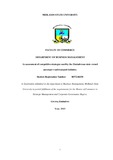Please use this identifier to cite or link to this item:
https://cris.library.msu.ac.zw//handle/11408/3885| Title: | An assessment of competitive strategies used by the Zimbabwean state owned passenger road transport industry. | Authors: | Zimvumi, Rumbidzai | Keywords: | competitive strategies transport industry |
Issue Date: | 2015 | Publisher: | Midlands State University | Abstract: | The research sought to assess the competitive strategies used by the Zimbabwean state owned passenger road transport industry. The basis of the research is that there have been many competitive strategies adopted by state owned road passenger transport organisations but there has not been any significant improvement in the performance of their organisations. Hence, it is with this background that the researcher saw it fit to assess the competitive strategies used by these state owned organisations. The research focused on identifying challenges to competitive strategy implementation, to establish competitive strategies used by their competitors, to identify factors influencing choice of competitive strategies as well as to identify how the government influences the competitive strategies used by the state owned passenger road transporters. The study used several scholars as a basis of literature to the study. Michael Porters model (1980) of five forces to competitive advantage was used as a backdrop to identify challenges that can affect competitive strategy implementation while studies done by Niclas (2014) explained the key factors to strategy implementation being strategy, structure and behaviour. The research was a pragmatic study which explored data using both the quantitative and qualitative methods. The target organisations were Zupco and Cmed, with a population of 183 employees and the sample was for 75 employees. Stratified random sampling was used to divide the target population into two groups of strata, management and general employees. Judgemental sampling was then used to select management representatives while simple random sampling was used to select respondents from the general employees’ category. Questionnaires and interviews were used to collect primary sources of data while secondary sources of data was collected from annual reports, journals, internet and books related to the subject matter. There was an 87% response rate from both the management and general employees due to their keen interest in the subject matter. The findings of the research highlighted that there are several challenges that affect competitive strategy implementation in state owned passenger road organisations. Some of these challenges are common in bureaucratic organisations while poor leadership is also a contributing factor. However, there are other strategies like effective leadership, communication, pricing and customer care that can be adopted to overcome the challenges to competitive strategy implementation. The competitive strategies being used by the private sector transporters are very effective and have pushed state owned transporters out of business but some of the strategies are illegal like touting, bribery and pick and drop at illegal points. While there are a lot of marketing and external factors that shape the choice of competitive strategy, the government contributes greatly to influencing competitive strategy implementation through its legislation as well as deliberate means like intentionally choosing state owned companies to ferry passengers during all state occasions. Conclusively, the study identified the main challenges to competitive strategy implementation and these were centralised around leadership and bureaucratic issues. The private road transporters have effective strategies that they use to be competitive like advertising, innovation and use of technology, a proper benchmark of these strategies could positively improve the performance of state owned passenger road transporters. The researcher recommended that state owned organisations should emphasise on effective leadership so as to improve communication between management and employees, encourage innovation and creativity and include employees in the formulation of competitive strategies. State owned organisations should also benchmark their major competitors and adopt other effective competitive strategies like customer care, diversification, making use of technology and promotions/advertising. | URI: | http://hdl.handle.net/11408/3885 |
| Appears in Collections: | Master Of Commerce In Strategic Management And Corporate Governance Degree |
Files in This Item:
| File | Description | Size | Format | |
|---|---|---|---|---|
| Final Dissertation Rumbidzai Zimvumi.pdf | Full Text | 1.24 MB | Adobe PDF |  View/Open |
Page view(s)
466
checked on Dec 16, 2025
Download(s)
1,426
checked on Dec 16, 2025
Google ScholarTM
Check
Items in MSUIR are protected by copyright, with all rights reserved, unless otherwise indicated.



